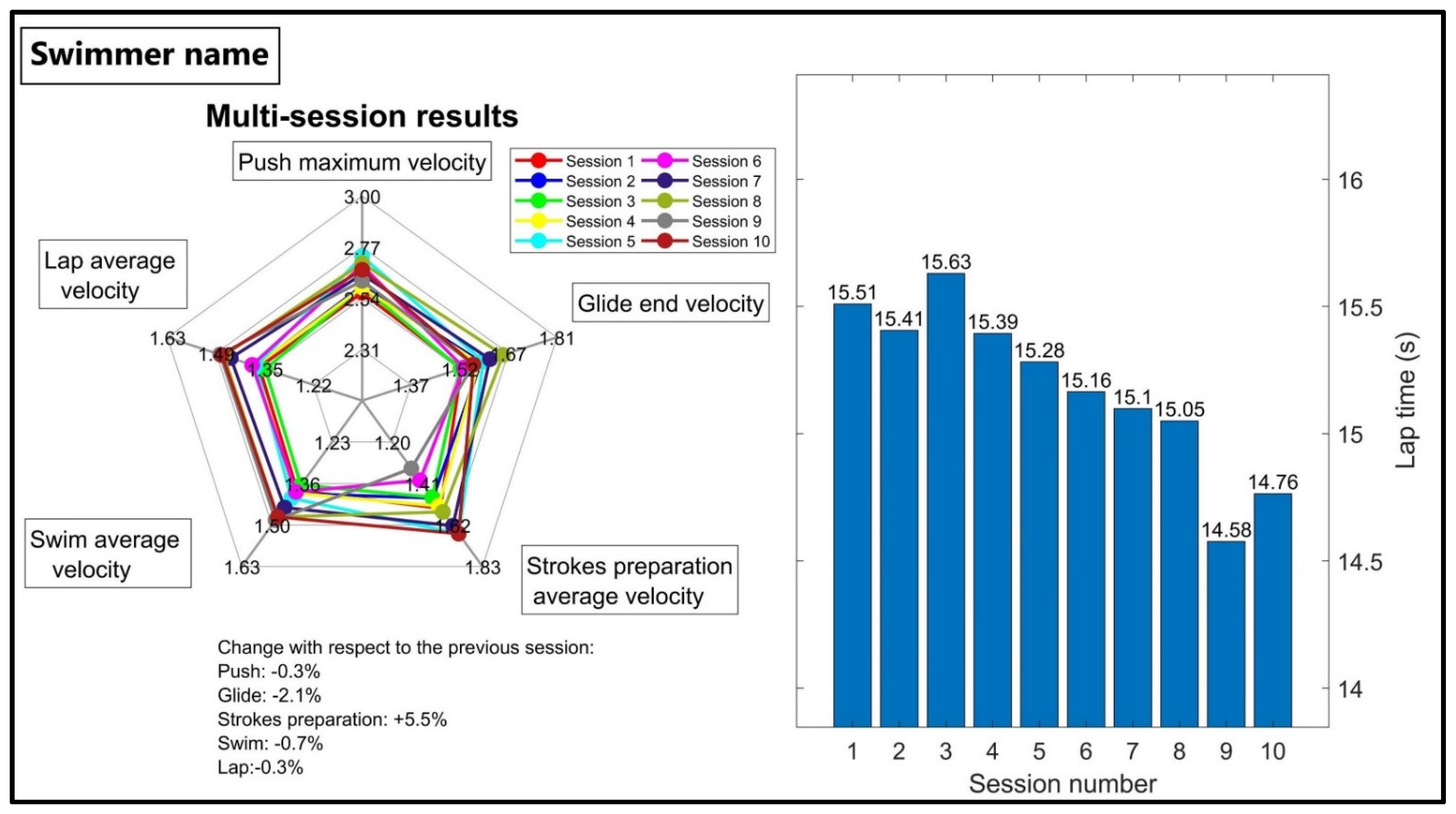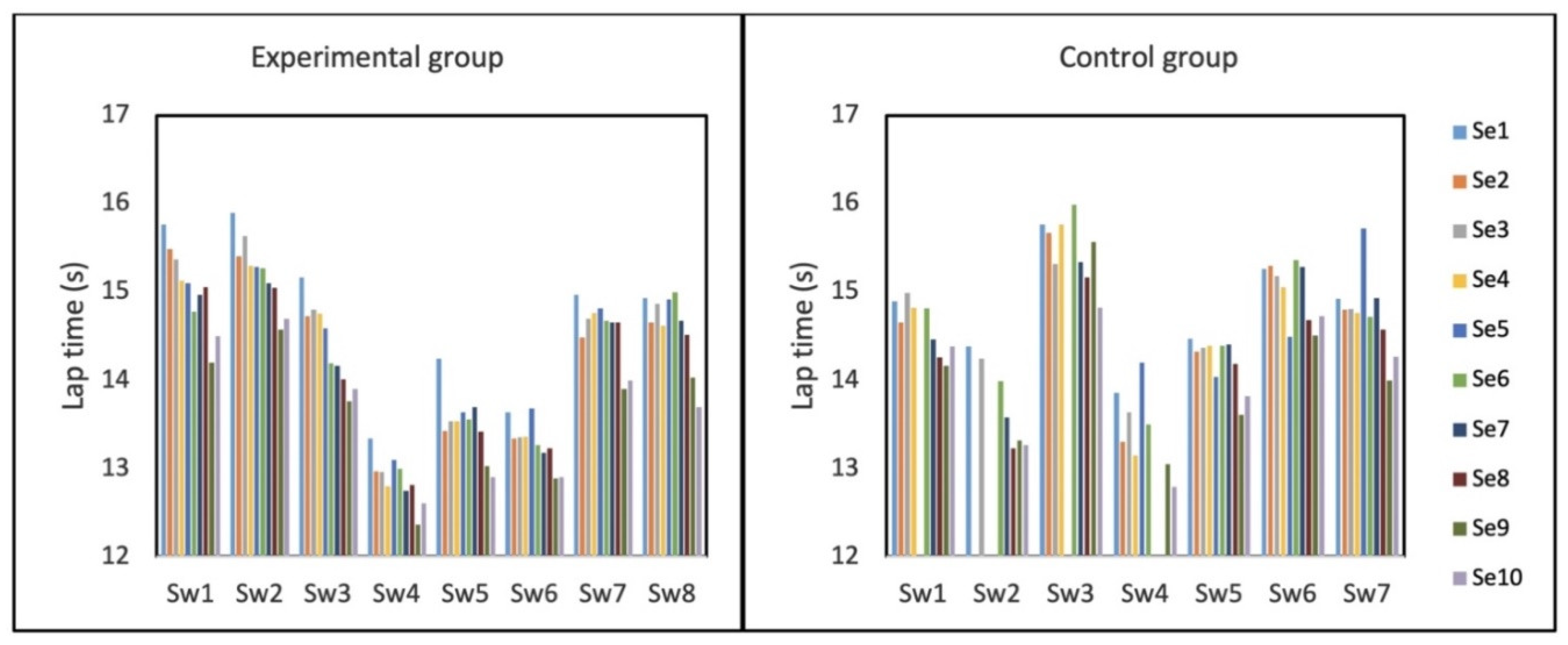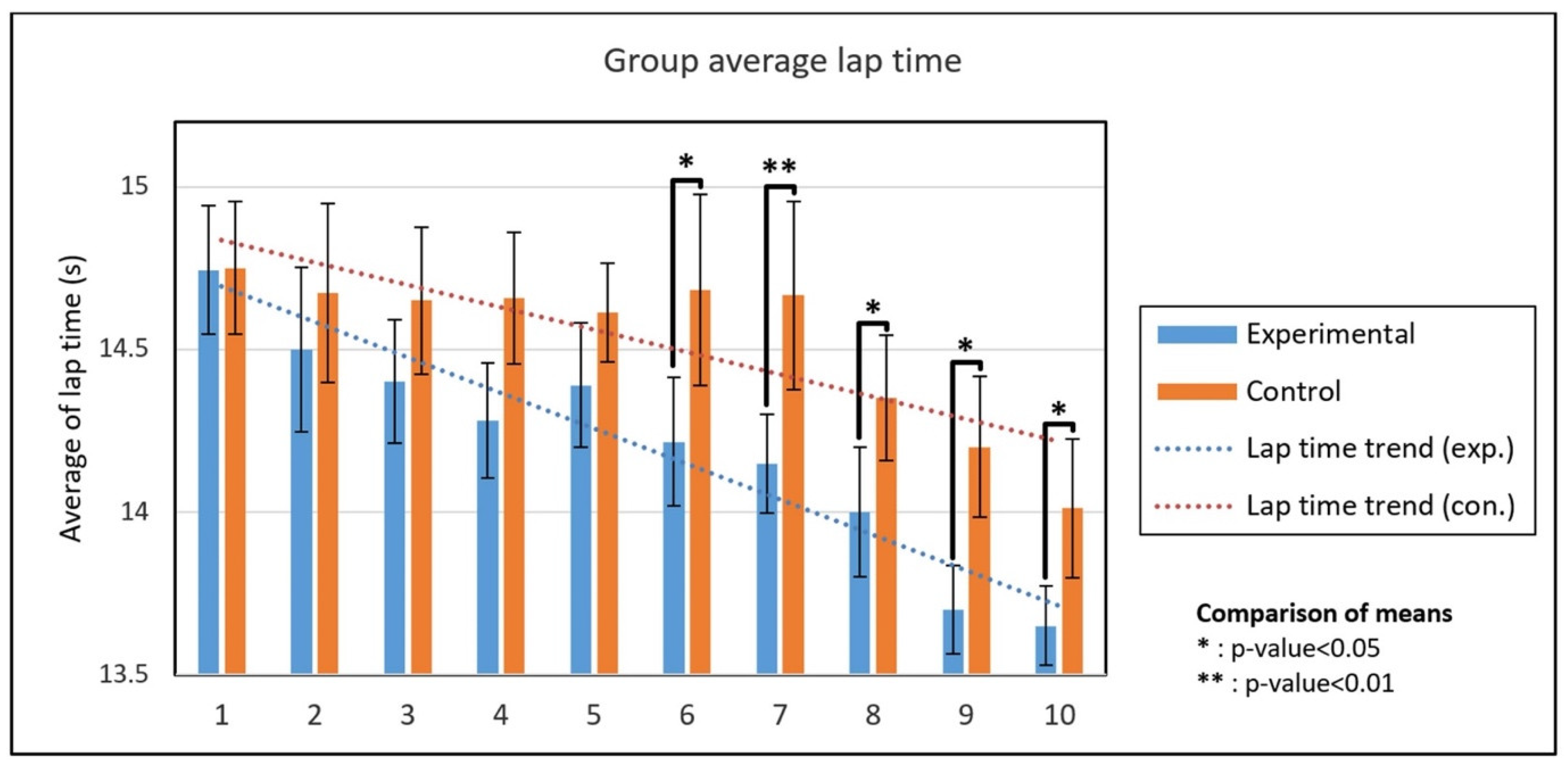SmartSwim, a Novel IMU-Based Coaching Assistance
Abstract
:1. Introduction
2. Materials and Methods
2.1. Measurement Setup and Protocol
Experimental and Control Groups
2.2. SmartSwim Solution for Swimming Analysis and Feedback
2.2.1. Phase-Based Performance Evaluation
- Push phase: push maximum velocity.
- Glide phase: glide end velocity.
- Strokes preparation phase: strokes preparation average velocity.
- Total Swim phase: swim phase average velocity.
- Swim phase strokes: average velocity per stroke of the swim phase.
- Whole lap: lap average velocity.
2.2.2. Feedback Reports and Illustrations
2.3. Feedback Effect Statistical Analysis
3. Results
3.1. Coach Interpretation
3.2. Statistical Analysis
4. Discussion
4.1. Using Feedback for Training
4.2. Experimental and Control Group Comparison
5. Conclusions
Author Contributions
Funding
Institutional Review Board Statement
Informed Consent Statement
Data Availability Statement
Acknowledgments
Conflicts of Interest
Appendix A. First and Tenth Weeks Comparison


Appendix B. Coach’s Observations and Interpretations
| Phase | Sample Observations | Comments, New Training and Tests |
|---|---|---|
| Push |
|
|
| Glide | ||
| Strokes prep. | ||
| Swim |
|
|
Appendix C. Session-Level Comparison Using Lap Average Velocity Goal Metric
| Test Session | 1 | 2 | 3 | 4 | 5 | 6 | 7 | 8 | 9 | 10 |
|---|---|---|---|---|---|---|---|---|---|---|
| Lap time comparison: t score | 0.29 | 0.44 | 0.78 | 1.02 | 0.86 | 2.33 * | 3.59 ** | 2.63 * | 2.01 * | 1.99 * |
| Standard deviation comparison: U score | 26 | 24 | 14 | 23 | 12 | 4 * | 7 * | 15 | 8* | 9 * |

References
- Wulf, G.; Shea, C.H. Principles Derived Form the Studies of Simple Motor Skills Do Not Generalize to Complex Skill Learning. Psychon. Bull. Rev. 2002, 9, 185–211. [Google Scholar] [CrossRef] [PubMed]
- Sigrist, R.; Rauter, G.; Riener, R.; Wolf, P. Augmented Visual, Auditory, Haptic, and Multimodal Feedback in Motor Learning: A Review. Psychon. Bull. Rev. 2013, 20, 21–53. [Google Scholar] [CrossRef] [PubMed] [Green Version]
- Jefferies, S.M.; Jefferies, C.M.; Donohue, S.; Mechanics, M. The Effect of Real Time Feedback on Swimming Technique. J. Int. Soc. Swim. Coach. 2012, 2, 41–47. [Google Scholar]
- Mooney, R.; Corley, G.; Godfrey, A.; Osborough, C.; Newell, J.; Quinlan, L.R.; ÓLaighin, G. Analysis of Swimming Performance: Perceptions and Practices of US-Based Swimming Coaches. J. Sports Sci. 2016, 34, 997–1005. [Google Scholar] [CrossRef]
- Berger, M.A.; Hollander, A.P.; De Groot, G. Technique and Energy Losses in Front Crawl Swimming. Med. Sci. Sports Exerc. 1997, 29, 1491–1498. [Google Scholar] [CrossRef]
- Pendergast, D.; Zamparo, P.; di Prampero, P.E.; Capelli, C.; Cerretelli, P.; Termin, A.; Craig, A.; Bushnell, D.; Paschke, D.; Mollendorf, J. Energy Balance of Human Locomotion in Water. Eur. J. Appl. Physiol. 2003, 90, 377–386. [Google Scholar] [CrossRef]
- Seifert, L.; Chollet, D.; Mujika, I. World Book of Swimming: From Science to Performance; Nova Science Publishers: New York, NY, USA, 2011; ISBN 978-1-61470-741-7. [Google Scholar]
- Payton, C.J.; Bartlett, R.M. Estimating Propulsive Forces in Swimming from Three-Dimensional Kinematic Data. J. Sports Sci. 1995, 13, 447–454. [Google Scholar] [CrossRef]
- Nikodelis, T.; Kollias, I.; Hatzitaki, V. Bilateral Inter-Arm Coordination in Freestyle Swimming: Effect of Skill Level and Swimming Speed. J. Sports Sci. 2005, 23, 737–745. [Google Scholar] [CrossRef]
- Payton, C.J.; Adrian Burden, E. Biomechanical Evaluation of Movement in Sport and Exercise: The British Association of Sport and Exercise Sciences Guide; Routledge: London, UK, 2017. [Google Scholar]
- Callaway, A.J.; Cobb, J.E.; Jones, I. A Comparison of Video and Accelerometer Based Approaches Applied to Performance Monitoring in Swimming. Int. J. Sports Sci. Coach. 2010, 4, 139–153. [Google Scholar] [CrossRef]
- Chollet, D.; Madani, M.; Micallef, J.P. Effects of Two Types of Biomechanical Bio-Feedback on Crawl Performance. Biomech. Med. Swim. Swim. Sci. VI 1992, 48, 53. [Google Scholar]
- Ukai, Y.; Rekimoto, J. Swimoid: A Swim Support System Using an Underwater Buddy Robot. In Proceedings of the 4th Augmented Human International Conference, Stuttgart, Germany, 7–8 March 2013; pp. 170–177. [Google Scholar] [CrossRef]
- Le Sage, T.; Bindel, A.; Conway, P.; Justham, L.; Slawson, S.; Webster, J.; West, A. A Multi-Sensor System for Monitoring the Performance of Elite Swimmers. Commun. Comput. Inf. Sci. 2012, 222, 350–362. [Google Scholar] [CrossRef]
- Ramos Félix, E.; da Silva, H.P.; Olstad, B.H.; Cabri, J.; Lobato Correia, P. SwimBIT: A Novel Approach to Stroke Analysis During Swim Training Based on Attitude and Heading Reference System (AHRS). Sports 2019, 7, 238. [Google Scholar] [CrossRef] [PubMed] [Green Version]
- Stamm, A.; James, D.A.; Burkett, B.B.; Hagem, R.M.; Thiel, D.V. Determining Maximum Push-off Velocity in Swimming Using Accelerometers. Procedia Eng. 2013, 60, 201–207. [Google Scholar] [CrossRef] [Green Version]
- Slawson, S.E.; Justham, L.M.; Conway, P.P.; Le-Sage, T.; West, A.A. Characterizing the Swimming Tumble Turn Using Acceleration Data. Proc. Inst. Mech. Eng. Part P J. Sport. Eng. Technol. 2012, 226, 3–15. [Google Scholar] [CrossRef]
- Dadashi, F.; Crettenand, F.; Millet, G.P.; Seifert, L.; Komar, J.; Aminian, K. Automatic Front-Crawl Temporal Phase Detection Using Adaptive Filtering of Inertial Signals. J. Sports Sci. 2013, 31, 1251–1260. [Google Scholar] [CrossRef] [PubMed]
- Bächlin, M.; Förster, K.; Tröster, G. SwimMaster: A Wearable Assistant for Swimmer. In Proceedings of the 11th International Conference on Ubiquitous Computing—Ubicomp’09, Orlando, FL, USA, 30 September–3 October 2009; p. 215. [Google Scholar] [CrossRef]
- Rocha, L.A.; Correia, J.H. Wearable Sensor Network for Body Kinematics Monitoring. In Proceedings of the 10th IEEE International Symposium on Wearable Computers, Montreux, Switzerland, 11–14 October 2006; pp. 137–138. [Google Scholar] [CrossRef]
- Silva, A.S.; Salazar, A.J.; Correia, M.F.; Borges, C.M. WIMU: Wearable Inertial Monitoring Unit—A MEMS-Based Device for Swimming Performance Analysis. In Proceedings of the International Conference on Biomedical Electronics and Devices—BIODEVICES, Rome, Italy, 26–29 January 2011; pp. 87–93. [Google Scholar] [CrossRef] [Green Version]
- Ehab, M.; Mohamed, H.; Ahmed, M.; Hammad, M.; Elmasry, N.; Atia, A. ISwimCoach: A Smart Coach Guiding System for Assisting Swimmers Free Style Strokes: ISwimCoach. In Proceedings of the ICMI 2020 Companion—Companion Publication of the 2020 International Conference on Multimodal Interaction, Virtual Event, 25–29 October 2020; pp. 265–269. [Google Scholar] [CrossRef]
- Mangin, M.; Valade, A.; Costes, A.; Bouillod, A.; Acco, P.; Soto-Romero, G. An Instrumented Glove for Swimming Performance Monitoring. In Proceedings of the 3rd International Congress on Sport Sciences Research and Technology Support—icSPORTS, Lisbon, Portugal, 15–17 November 2015; pp. 53–58. [Google Scholar] [CrossRef]
- Hamidi Rad, M.; Gremeaux, V.; Dadashi, F.; Aminian, K. A Novel Macro-Micro Approach for Swimming Analysis in Main Swimming Techniques Using IMU Sensors. Front. Bioeng. Biotechnol. 2021, 8, 1–16. [Google Scholar] [CrossRef] [PubMed]
- Hamidi Rad, M.; Aminian, K.; Gremeaux, V.; Massé, F.; Dadashi, F. Swimming Phase-Based Performance Evaluation Using a Single IMU in Main Swimming Techniques. Front. Bioeng. Biotechnol. 2021, 9, 793302. [Google Scholar] [CrossRef]
- Kendall, M.G. Rank Correlation Methods; Hafner Publishing Company: New York, NY, USA, 1995. [Google Scholar]
- Gilbert, R.O. Statistical Methods for Environmental Pollution Monitoring; John Wiley & Sons: Hoboken, NJ, USA, 1987; ISBN 0471288780. [Google Scholar]
- Lilliefors, H.W. On the Kolmogorov-Smirnov Test for Normality with Mean and Variance Unknown. J. Am. Stat. Assoc. 1967, 62, 399–402. [Google Scholar] [CrossRef]
- Kim, T.K. T Test as a Parametric Statistic. Korean J. Anesthesiol. 2015, 68, 540–546. [Google Scholar] [CrossRef] [Green Version]
- Nachar, N. The Mann-Whitney U: A Test for Assessing Whether Two Independent Samples Come from the Same Distribution. Tutor. Quant. Methods Psychol. 2008, 4, 13–20. [Google Scholar] [CrossRef]
- Mann, H.B.; Whitney, D.R. On a Test of Whether One of Two Random Variables Is Stochastically Larger than the Other. Ann. Math. Stat. 1947, 18, 50–60. [Google Scholar] [CrossRef]
- Irwin, G.; Hanton, S.; Kerwin, D. Reflective Practice and the Origins of Elite Coaching Knowledge. Reflective Pract. 2004, 5, 425–442. [Google Scholar] [CrossRef]
- Dadashi, F.; Millet, G.P.; Aminian, K. Front-Crawl Stroke Descriptors Variability Assessment for Skill Characterization. J. Sports Sci. 2016, 34, 1405–1412. [Google Scholar] [CrossRef] [PubMed]
- Lerda, R.; Cardelli, C.; Chollet, D. Analysis of the Interactions between Breathing and Arm Actions in the Front Crawl. J. Hum. Mov. Stud. 2001, 40, 129–144. [Google Scholar]
- Wakayoshi, K.; Yoshida, T.; Udo, M.; Kasai, T.; Moritani, T.; Mutoh, Y.; Miyashita, M. A Simple Method for Determining Critical Speed as Swimming Fatigue Threshold in Competitive Swimming. Int. J. Sports Med. 1992, 13, 367–371. [Google Scholar] [CrossRef]
- Toner, J.; Moran, A. Toward an Explanation of Continuous Improvement in Expert Athletes: The Role of Consciousness in Deliberate Practice. Int. J. Sport Psychol 2015, 46, 666–675. [Google Scholar]
- Stewart, A.M.; Hopkins, W.G. Consistency of Swimming Performance within and between Competitions. Med. Sci. Sports Exerc. 2000, 32, 997–1001. [Google Scholar] [CrossRef]
- Nash, C.; Sproule, J.; Horton, P. Feedback for Coaches: Who Coaches the Coach? Int. J. Sport. Sci. Coach. 2017, 12, 92–102. [Google Scholar] [CrossRef]
- Koutedakis, Y. Seasonal Variation in Fitness Parameters in Competitive Athletes. Sport. Med. 1995, 19, 373–392. [Google Scholar] [CrossRef]
- Bielec, G.; Makar, P.; Foliñski, P. Biomechanical Effects of Application of the Technique Exercises in Young Swimmer Training. In SWIMMING II; Wydawnictwo AWF: Wrocław, Poland, 2008; p. 51. [Google Scholar]
- Sheard, M.; Golby, J. Effect of a Psychological Skills Training Program on Swimming Performance and Positive Psychological Development. Int. J. Sport Exerc. Psychol. 2006, 4, 149–169. [Google Scholar] [CrossRef]
- Shaw, G.; Boyd, K.T.; Burke, L.M.; Koivisto, A. Nutrition for Swimming. Int. J. Sport Nutr. Exerc. Metab. 2014, 24, 360–372. [Google Scholar] [CrossRef] [PubMed] [Green Version]
- de Magalhaes, F.A.; Vannozzi, G.; Gatta, G.; Fantozzi, S. Wearable Inertial Sensors in Swimming Motion Analysis: A Systematic Review. J. Sports Sci. 2015, 33, 732–745. [Google Scholar] [CrossRef] [PubMed]
- Toubekis, A.G.; Drosou, E.; Gourgoulis, V.; Thomaidis, S.; Douda, H.; Tokmakidis, S.P. Competitive Performance, Training Load and Physiological Responses during Tapering in Young Swimmers. J. Hum. Kinet. 2013, 38, 125. [Google Scholar] [CrossRef] [PubMed] [Green Version]
- Bar-Eli, M.; Dreshman, R.; Blumenstein, B.; Weinstein, Y. The Effect of Mental Training with Biofeedback on the Performance of Young Swimmers. Appl. Psychol. 2002, 51, 567–581. [Google Scholar] [CrossRef]
- Gussakov, I.; Nurmukhanbetova, D.; Kulbayev, A.; Yermakhanova, A.; Lesbekova, R.; Potop, V. The Impact of the High Level of Intensity Training Process on the Performance and Recovery of Young Swimmers at the National Level. J. Phys. Educ. Sport 2021, 21, 440–443. [Google Scholar]







| Group | Male | Female | Age (yrs) | Height (cm) | Body Mass (kg) | First Session Record in Seconds (Baseline) |
|---|---|---|---|---|---|---|
| Experimental | 4 | 4 | 14.5 ± 0.5 | 170.1 ± 6.5 | 55.5 ± 8.3 | 14.74 ± 0.87 |
| Control | 4 | 3 | 14.6 ± 0.4 | 171.2 ± 7.1 | 54.9 ± 7.2 | 14.75 ± 0.79 |
| Experimental Group Lap Time Trends—S Value | |||||||||||||
|---|---|---|---|---|---|---|---|---|---|---|---|---|---|
| Sw1 | Sw2 | Sw3 | Sw4 | Sw5 | Sw6 | Sw7 | Sw8 | ||||||
| −37 * | −41 * | −39 * | −31 * | −19 | −29 * | −25* | −23 * | ||||||
| Control Group Lap Time Trends—S Value | |||||||||||||
| Sw1 | Sw2 | Sw3 | Sw4 | Sw5 | Sw6 | Sw7 | |||||||
| −24 * | −17 * | −16 | −14 | −18 | −15 | −23 * | |||||||
| Test Session | 1 | 2 | 3 | 4 | 5 | 6 | 7 | 8 | 9 | 10 |
|---|---|---|---|---|---|---|---|---|---|---|
| Lap time comparison: t score | 0.27 | 1.62 | 1.36 | 1.81 | 1.12 | 2.39 * | 2.79 ** | 2.09 * | 2.40 * | 1.99 * |
| Standard deviation comparison: U score | 25 | 18 | 17 | 16 | 10 | 9 * | 7 * | 13 | 5 * | 9 * |
Publisher’s Note: MDPI stays neutral with regard to jurisdictional claims in published maps and institutional affiliations. |
© 2022 by the authors. Licensee MDPI, Basel, Switzerland. This article is an open access article distributed under the terms and conditions of the Creative Commons Attribution (CC BY) license (https://creativecommons.org/licenses/by/4.0/).
Share and Cite
Hamidi Rad, M.; Gremeaux, V.; Massé, F.; Dadashi, F.; Aminian, K. SmartSwim, a Novel IMU-Based Coaching Assistance. Sensors 2022, 22, 3356. https://doi.org/10.3390/s22093356
Hamidi Rad M, Gremeaux V, Massé F, Dadashi F, Aminian K. SmartSwim, a Novel IMU-Based Coaching Assistance. Sensors. 2022; 22(9):3356. https://doi.org/10.3390/s22093356
Chicago/Turabian StyleHamidi Rad, Mahdi, Vincent Gremeaux, Fabien Massé, Farzin Dadashi, and Kamiar Aminian. 2022. "SmartSwim, a Novel IMU-Based Coaching Assistance" Sensors 22, no. 9: 3356. https://doi.org/10.3390/s22093356
APA StyleHamidi Rad, M., Gremeaux, V., Massé, F., Dadashi, F., & Aminian, K. (2022). SmartSwim, a Novel IMU-Based Coaching Assistance. Sensors, 22(9), 3356. https://doi.org/10.3390/s22093356








